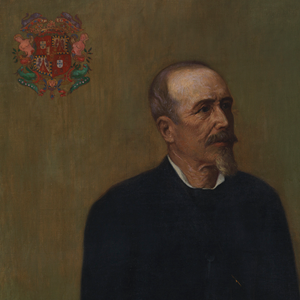

Descendant of the marquees of Vila Real and of Angeja, D. Francisco de Noronha e Menezes, the last nobleman of the Prelada, was the son of Manuel de Noronha e Menezes de Mesquita e Melo and D. Jeanne-Françoise Etienette Vincent, of French origin.
Some ancestors of Noronha e Menezes family had ties to the Misericórdia do Porto. We highlight, D. Luísa Pessoa who, at the end of the 16th century, was patroness of the Misericórdia and also the first "sister" in a time when the Brotherhood was an institution for men. D. António de Noronha e Menezes de Mesquita e Melo, was elected Provedor (equal to president) in 1756.
Of the marriage between D. Manuel and D. Jeanne-Françoise eight children were born: Manuel, Francisco, Antonio, Ana Cristina, Francisca Júlia, Guiomar, Maria and Joaquina. The eldest son, Manuel, died in the Senhora Branca in Braga, due to a fall of a horse. Because of this, Francisco became the eldest son. The father bestowed upon him a third of his estate, which included the Quinta da Prelada (an estate home) in the parish of Paranhos, then on the outskirts of the city of Porto.
D. Manuel was a very wealthy nobleman, owning properties in Braga, Guimarães, Monção, Felgueiras and in Porto. After his death, which occurred in 1870, D. Francisco de Noronha e Menezes inherited the estate home. He married D. Maria Cristina Pereira Gaio de Noronha, his cousin, who died in 1883. They had a son, named Francisco de Noronha e Menezes Júnior., who died in 1890, victim of tuberculosis.
In the 16th of May 1903, D. Francisco wrote his will in which he set the following:
"[...] I here by name heir of the remains of my estate, the Santa Casa da Misericórdia of Porto, which is constituted by, inter alia, the remnant of the following assets, which I own the parishes of Ramalde and Paranhos [...]
[...] I want that the Casa da Quinta da Prelada (the estate home), within its walls, and in a time frame of two years, be destined for a Convalescence Hospital, or other humanitarian purpose, belonging in perpetuity to the Santa Casa da Misericórdia do Porto, because it is under this express condition that I institute it heir to the remnant of my inheritance [...]. "
He died in February 26th 1904 and was buried in Agramonte cemetery.
Fulfilling his testamentary disposition, on the 26th of February 1906, two years after the death of this great benefactor, the Santa Casa da Misericórdia do Porto inaugurated on the Casa da Prelada a Convalescence Hospital.
At first, this hospital began by housing female convalescent patients sent by the Hospital de Santo António.
Later, in 1953, the Convalescence Hospital began admitting children and also had medical consults, with whither the internment or the medical consults, depending on the Hospital de Santo António pediatric service.
From 1961 forward the Casa da Prelada went on to play a role of a center for the recovery of people with decreased physical mobility. Of the activities carried out the, we highlight the Occupational Therapy section. The physical therapy, occupation, interest and to even the vocation of some of the interned was carried out and explored there.
From 1973 onwards, the building was transformed into a retirement home having maintained this activity for thirty years.
The Quinta (Villa) da Prelada
Located in the parish of Paranhos, next to the Carvalhido, on the route of the Ways of Saint James, the Quinta da Prelada was elected as one of the most notable and great spaces of the Porto suburbs.
In 1758, in the Memórias Paroquiais de Ramalde (a book about the memories of the Paranhos parish, father Francisco Mateus Xavier de Carvalho made a full description of the property, pointing out that it was the best in the province and that the Villa was drawn by Nasoni, the Italian painter, who lived in the city of Porto.
This vast architectural and landscape set was subordinate to an axis of symmetry that passed through the center of the house and ended at the Castle. Along this route various spaces and elements of the landscape of the Villa were organized. The Memórias Paroquias are very enlightening about this, describing fountains, lakes, freshly painted benches, a boxwood maze, and sculptures, among other elements.
After the closure of the D. Francisco de Noronha nursing home, the house and surrounding gardens were subjected to a deep recovery, having been returned to the city in 2013.
Portrait of D. Francisco de Noronha e Menezes
Painted by António Carneiro, the portrait of D. Francisco de Noronha e Menezes is exhibited at MMIPO in the room devoted to the history and action of the Misericórdia do Porto, it features a neutral background and the figure of the patron in an informal pose, which gives it streaking naturalness and legitimacy. These features are enhanced with the clarification that the painter gave to affix next to his signature, "cop de photographia" (copy of a photograph). This photo is part of the photographic collection of the historical archive of the Santa Casa da Misericórdia do Porto, located today in the Casa da Prelada - D. Francisco de Noronha e Menezes.
D. Francisco de Noronha e Menezes
António Carneiro
Early twentieth century
Oil on canvas
251 x 132 cm


.jpg)

